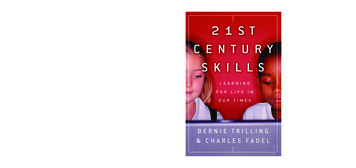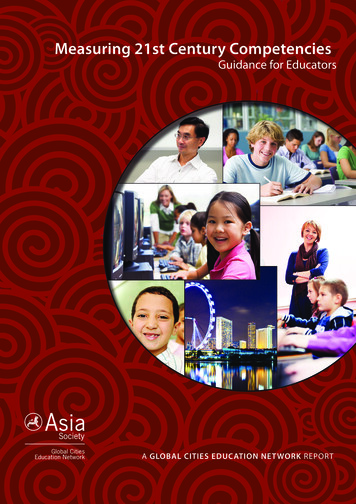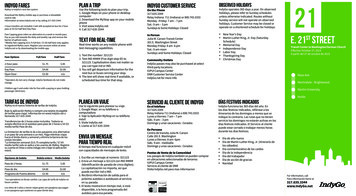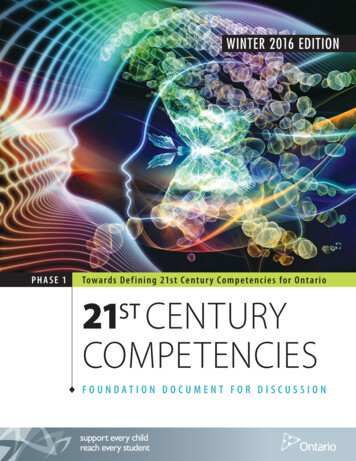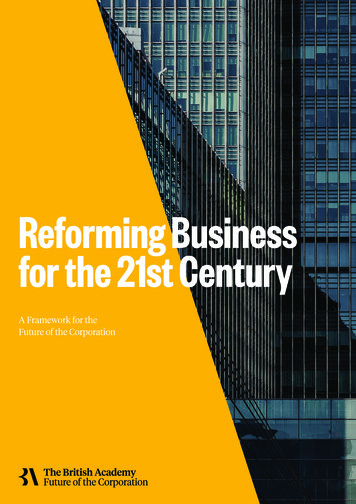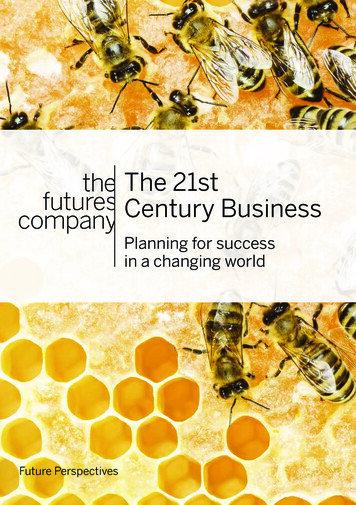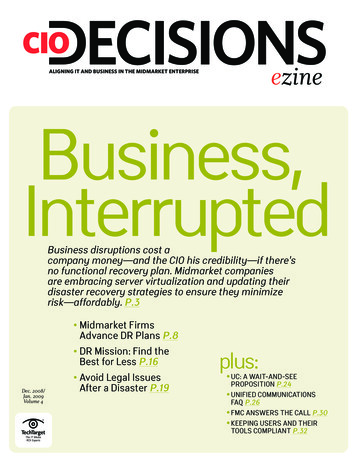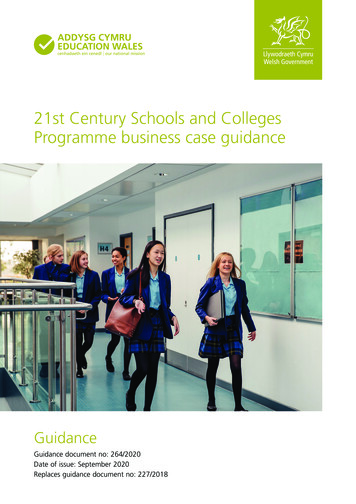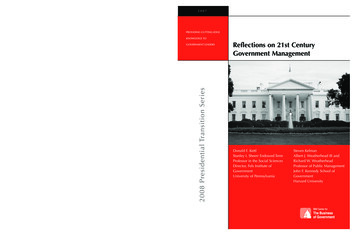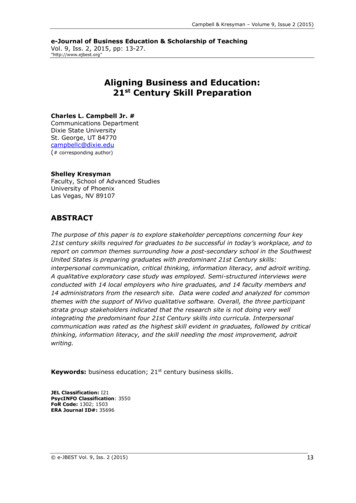
Transcription
Campbell & Kresyman – Volume 9, Issue 2 (2015)e-Journal of Business Education & Scholarship of TeachingVol. 9, Iss. 2, 2015, pp: 13-27.”http://www.ejbest.org”Aligning Business and Education:21st Century Skill PreparationCharles L. Campbell Jr. #Communications DepartmentDixie State UniversitySt. George, UT 84770campbellc@dixie.edu(# corresponding author)Shelley KresymanFaculty, School of Advanced StudiesUniversity of PhoenixLas Vegas, NV 89107ABSTRACTThe purpose of this paper is to explore stakeholder perceptions concerning four key21st century skills required for graduates to be successful in today’s workplace, and toreport on common themes surrounding how a post-secondary school in the SouthwestUnited States is preparing graduates with predominant 21st Century skills:interpersonal communication, critical thinking, information literacy, and adroit writing.A qualitative exploratory case study was employed. Semi-structured interviews wereconducted with 14 local employers who hire graduates, and 14 faculty members and14 administrators from the research site. Data were coded and analyzed for commonthemes with the support of NVivo qualitative software. Overall, the three participantstrata group stakeholders indicated that the research site is not doing very wellintegrating the predominant four 21st Century skills into curricula. Interpersonalcommunication was rated as the highest skill evident in graduates, followed by criticalthinking, information literacy, and the skill needing the most improvement, adroitwriting.Keywords: business education; 21st century business skills.JEL Classification: I21PsycINFO Classification: 3550FoR Code: 1302; 1503ERA Journal ID#: 35696 e-JBEST Vol. 9, Iss. 2 (2015)13
Campbell & Kresyman – Volume 9, Issue 2 (2015)IntroductionGovernment and business leaders are calling for reform across all academic levelsespecially in the collegiate arena where the greatest misalignment exists between 21stCentury employer needs and university deliverables (Daggett, 2005). As businessenterprises, post-secondary academic institutions have social and economicresponsibilities to respective local, state, and national business communities toprepare graduates with contemporary skills needed to become productive members ofsociety (Lehmann, 2009). The need to determine if colleges and universities areteaching and refining students with the 21st Century skills employers are demandingis imperative (Harvard, 2011; Palmer, Scribner & Zajonc, 2010).Bushaw and Lopez (2012) found that less than 10% of high school dropouts and lessthan 20% of high school graduates possess 21st Century skills needed to succeed inthe modern workforce. Additionally, less than 33% of high school graduates haveskills necessary to enter post-secondary academic programs (Bushaw & Lopez, 2012).Americans view college graduation as the principle benchmark for workforce readinessbut only 54% agreed college graduates understand and retain 21st Century skillssought after by contemporary employers (Bushaw & Lopez, 2012).In the United States, the post-secondary educational system is in an alarming, yetsilent and misaligned state of panic (Friedman, 2005). Panic in secondary educationalinstitutions has resulted in uncaring and frustrated students, decentralized curriculumand teaching pedagogies, frustrated employers seeking graduates with 21st Centuryskills, and a decrease in financial support from taxpayers and philanthropic groups(Friedman, 2005). A primary area of reform involves whether or not studentsentering the 21st Century workforce comprehend what is required and can implementthe 21st Century skills needed to flourish in the contemporary workplace (Trilling &Fadel, 2012).Literature ReviewPreparing for a career in the 21st Century workplace involves more than thecompletion of a particular post-secondary degree (Correll, 2001). Students’understanding about available career paths and specific skills desired by contemporaryemployers should be developed during the college years (Magnuson & Starr, 2000).Post-secondary academic institutions are at least partly responsible for future successrates of graduates, as students form perceptions of the 21st Century labor market andcareer goals during the college years (Magnuson & Starr, 2000).Post-secondary education systems operate under a business model, which has notadapted to contemporary employment realities, concerns, and business needs(Bookman, 2010).Institutions of higher learning have been slow to change and keep up withcontemporary needs of the workforce (Palmer, Scribner & Zajonc, 2010). One of thegreatest challenges for modern business management is finding and retaining qualifiedindividuals with the 21st Century skills needed to achieve stated business goals(Kezar, 2009). A crucial element for business and educational leaders should be toalign workplace needs with higher education preparation systems to promote studentsuccess in a career after graduation, rather than simply focusing on traditionalacademic achievements or grades (Harvard 2011).Attending college and becoming career-ready often requires more from students thansimply performing well academically (ACTE, 2014). Problem and design-basedteaching methods align with individual propensities 21st Century employers areseeking (Lehmann, 2009). Cohort designed programs focusing on problem-based e-JBEST Vol. 9, Iss. 2 (2015)14
Campbell & Kresyman – Volume 9, Issue 2 (2015)experiential learning assist students with developing content knowledge in harmonywith authentic, real-world problems and questions students might experience in theprofessional arena (Lehmann, 2009). Employability should be sustainable (Watts,2006).Sustainable employability refers not only to the development of skills, which wouldenhance opportunities when job hunting but also concerns acquiring skills to sustainemployment for the long-term, or to transition into new opportunities as needed(Watts, 2006). Critics accuse post-secondary faculty members of teaching the sameclasses in the same manner with the same materials used for decades with noupgrades in curriculum, delivery methods, or learning objectives that align withchanges in the workplace (Pietka, 2007). In short, students do not have skills neededfor the modern workplace (Pietka, 2007). If 21st Century post-secondary schools aregoing to attract and retain quality learners, faculty must participate in workshopsregarding how to connect with technology-driven students (Pietka, 2007).These activities along with campus-wide efforts focusing on the integration of laptops,smart-phones, and other personal technology devices may place students at odds withfaculty in the classroom (Pietka, 2007). Post-secondary educational institutionsshould consider the needs of the 21st Century world of business because success orfailure of graduates is a direct reflection of the training and preparedness of the school(Taylor, 2010). If today’s higher learning institutions were placing the requisites ofgraduates at the forefront of instructional practices, a majority of the frustrationscaused by misalignment between employers, schools, and students would not exist.The future of the American workforce is lacking in 21st Century skills demanded bythe modern global workforce (Casner-Lotto & Benner, 2006). Current literatureidentifies four highly sought after skills for the contemporary workplace includinginterpersonal communication, critical thinking, information literacy, and adroit writing.Given the pressures for academic reform from modern employers, students,government officials, and private and public scholarship foundations, the need toexamine frontline academic stakeholder perceptions regarding the definition andclassroom integration levels of the 21st Century skills should reveal prudent courses ofaction to address the problem (Taylor, 2010).Global economies have shifted priorities in proficiencies needed by employees in the21st Century (Gardner, 2011; Trilling & Fadel, 2012; Wagner, 2008). The Partnershipfor 21st Century Skills (P21), a collaborative created by a consortium of businessleaders, (including Fortune 500 firms including Apple, Ford, Microsoft, TexasInstruments, and Verizon), departments of education, and research organizations wasan initiative to develop a framework for secondary and post-secondary students to beprepared for success in the 21st century workplace (Trilling & Fadel, 2012). Accordingto the consortium research, critical thinking and problem solving, information/digitalliteracy, communication and collaboration, and creativity and innovation wereidentified as groups of skills modern employers seek in graduates entering theworkforce (Trilling & Fadel, 2012). Following an extensive review of the literatureprovided by the consortium, four of these skills were repetitively identified as keyskills highly sought after by contemporary employers: interpersonal communication,critical thinking, information literacy, and adroit writing (Partnership, 2014; Trilling &Fadel, 2012).Critical thinking is a way of distinguishing significant elements from insignificant data(Browne & Keeley, 1986). A critical thinker scrutinizes assumptions, detects hiddenvalues, evaluates evidence, assesses conclusions, identifies fallacies, exploresproblems, asks pertinent questions, creates effective solutions, and justifies actions(Petress, 2004). If students are to become critical thinkers educators should provideopportunities for learners to express different views and to work through independent e-JBEST Vol. 9, Iss. 2 (2015)15
Campbell & Kresyman – Volume 9, Issue 2 (2015)thinking, deciphering how the views of others fit in with personal opinions (Paul,2001).Information literacy involves the capacity to find and appropriately apply validated anduseful evidence, a 21st Century skill that is vital to modern employers (Latham &Gross, 2013). Contemporary information literacy requires using the Interneteffectively to manage, access, and discern information with technology (Shana &Ishtaiwa, 2013).Interpersonal communication is a dynamic form of communication, between two ormore individuals, where the message influences thoughts, emotions, behaviors andrelationships (McCornack, 2010). Individuals employing efficient interpersonalcommunication abilities are not only aware of family, friend, work and romanticrelationship types; but can also apply competent listening, cultural sensitivity,emotional intelligent and conflict management styles across all kinds of humanassociations (DeVito, 2009).Adroit writing surrounds the aptitude to transcribe language into written forms withfew or no errors in spelling, grammar, syntax, flow, structure, or meaning relating to aspecific topic (Mascle, 2013). A primary goal of secondary and post-secondaryacademic institutions is to prepare leaners with fundamental scripting blocks, whichwould transfer later into the writing needs of 21st Century employers (Mascle, 2013).Some of the most important adroit writing implications modern employers seekinclude data organization, stakeholder relationships, creativity, planning, reporting,emotional intelligence, and ethics (Mascle, 2013).MethodThe purpose of the exploratory case study was to uncover stakeholder perceptionsconcerning four key 21st century skills required for graduates to be successful intoday’s workplace, and to report on common themes surrounding how a postsecondary school in the southwest United States is preparing graduates withpredominant 21st Century skills: interpersonal communication, critical thinking,information literacy, and adroit writing. An exploratory case study design was used touncover common themes surrounding the central research question. Data collectionoccurred during individual semi-structured interviews using open-ended interviewquestions (Merriam, 2009; Shank, 2006; Yin, 2003). The study addressed theprimary research question: How is a post-secondary educational institution in thesouthwest region of the United States preparing graduates with the top four 21stCentury skills needed to succeed in the contemporary business world?The research site was a four-year university in the southwest region of the UnitedStates. Three strata groups served as study participants: (1) local employers whohired research site graduates in the past five years (2) faculty members, and (3)administrators from the research site. Random sampling was utilized to selectindividual participants belonging to the larger strata populations. Lists of universityfaculty and administration were obtained from the research site and lists of localemployers who hired graduates were obtained from the Office of Graduate Support.All three lists were edited so that none of the participants were former students,supervisors, or friends of the researcher to prevent conflict of interest or bias(Bryman, 2012). Members of each strata group (20 employers, 25 administrators, 40faculty) were assigned a numerical value and each list was randomly sorted viaMicrosoft Excel functions, aligning with the operational premise of random sampling inqualitative studies (Bryman, 2012).Following study email invitations and participant written consent, 42 semi-structuredinterviews took place over a 60 day period. Participants included 14 members from e-JBEST Vol. 9, Iss. 2 (2015)16
Campbell & Kresyman – Volume 9, Issue 2 (2015)each strata group. Delivering open-ended interview questions to multiple randomsample strata groups provided converging lines of inquiry, yielding rich, more accurateconclusions (Yin, 2009). Field study questions were delivered during the first fiveinterviews of each participant strata group involved in this study (Yin, 2009). Thepurpose of the field study was to validate the credibility of the interview questions.The first five randomly selected subjects from each strata group read through theinterview questions and answered two field test inquiries pertaining to the clarity ofthe interview questions and the alignment with the study purpose and primaryresearch question (Merriam, 2009; Shank, 2006; Yin, 2009). Field study participantswere treated in the same manner as other study participants in regards to humanright and protection protocols. An advantage of field testing in an exploratory casestudy design is that it allows the field test participants to be included in the mainsubject groups if the responses to validity questioning are conclusive (Babbie, 2012,Merriam, 2009, Shank, 2006). All 15 field test participants in the study offeredaffirming responses that the interview instrument questions were clear,understandable and aligned well with the purpose and primary research question ofthe study (Cozby, 2009; Yin, 2009).Responses obtained from 42 open-ended interviews were transcribed, scrubbed andcoded into appropriate nodes utilizing the NVivo qualitative software program forthematic analysis. Nodes, or thematic bins, were created using key words andphrases mined from the literature review and aligned with the interview questions.Data collection and analysis began during the first participant interview, continuedthroughout all process venues, and ceased when data saturation occurred. Datasaturation, when no new information pertinent to the study is revealed, (Leedy &Ormrod, 2009) occurred after 14 subject participants were interviewed from eachstrata group. A thorough and exhaustive exploration for common themes surroundingthe primary research question took place. by comparing, contrasting, and performingregular reviews of audio files, transcribed and scrubbed documents, key words andphrases used to create nodes in NVivo and the manual coding of data into thematicbins. In this manner, the rich data obtained from the different strata group interviewresponses developed into relevant common themes surrounding the primary researchquestion of the study. Several common themes directly related to the purpose andprimary research question of this study emerged.ResultsSeveral common themes related to graduates’ 21st Century skill preparation emergedfrom the analyses. In the study, ten interview questions were posed to participants inthree educational stakeholder strata groups including administrators, faculty and localemployers hiring or interviewing research site graduates in the past five years. Oddnumbered interview queries involved participants offering individual understanding ofthe four top 21st Century skills explored in the study. Even numbered inquiries posedto subjects surrounded thoughts and opinions on the integration levels of thepredominant four 21st Century skills at the research site.The first interview question posed to 14 employer, 14 administrator and 14 facultymember subject participants involved their perceptions to the meaning of the 21stCentury skill, critical thinking. Responses included the terms analysis (42%),considering all sides (16%) and thinking outside the box (10%). e-JBEST Vol. 9, Iss. 2 (2015)17
Campbell & Kresyman – Volume 9, Issue 2 (2015)Table 1Interview Question One - Bar Graph IllustrationsThe second interview question posed to all three subject participant groups involvedtheir perceptions on the level of integration of the 21st Century skill critical thinking inthe classroom at the selected research site (administrators and faculty members) andpracticed by graduates of the site (local employers). Four themes emerged regardingsubjects’ perceptions of critical thinking skills integrated in the classroom, and theability for graduates to apply the skill Results included really bad (14%), bad (19%),good (40%) and really good (5%).Table 2Interview Question Two - Bar Graph Illustrations e-JBEST Vol. 9, Iss. 2 (2015)18
Campbell & Kresyman – Volume 9, Issue 2 (2015)The third interview question posed to all three subject participant groups involvedtheir perceptions to the meaning of the 21st Century skill, information literacy. Threeprimary themes emerged including finding (35%), reading (31%) and understandingand applying information (16%).Table 3Interview Question Three - Bar Graph IllustrationsThe fourth interview question posed to all three subject participant groups involvedtheir perceptions on the level of integration of the 21st Century skill informationliteracy in the classroom at the selected research site (administrators and facultymembers) and practiced by graduates of the site (local employers). Four themesemerged including really bad (12%), bad (19%), good (43%) and really good (5%). e-JBEST Vol. 9, Iss. 2 (2015)19
Campbell & Kresyman – Volume 9, Issue 2 (2015)Table 4Interview Question Four - Bar Graph IllustrationsThe fifth interview question posed to all three subject participant groups involved theirperceptions to the meaning of the 21st Century skill, adroit writing. Three themesemerged including grammar (19%), spelling (14%) and sentence/structure (combinedat 25%).Table 5Interview Question Five - Bar Graph Illustrations e-JBEST Vol. 9, Iss. 2 (2015)20
Campbell & Kresyman – Volume 9, Issue 2 (2015)The sixth interview question posed to all three subject participant groups involvedtheir perceptions on the level of integration of the 21st Century skill adroit writing inthe classroom at the selected research site (administrators and faculty members) andpracticed by graduates of the site (local employers). Four themes regarding subjectperception of information literacy in the classroom and graduates emerged includingreally bad (21%), bad (31%), good (33%) and really good (5%).Table 6Interview Question Six - Bar Graph IllustrationsThe seventh interview question posed to all three subject participant groups involvedtheir perceptions to the meaning of the 21st Century skill, interpersonalcommunications. Three combined themes emerged including communicating and e-JBEST Vol. 9, Iss. 2 (2015)21
Campbell & Kresyman – Volume 9, Issue 2 (2015)expression verbally and non-verbally (combined at 46%), interacting and gettingalong within interpersonal relationships (combined at 38%) and listening andunderstanding (combined at 13%).Table 7Interview Question Seven - Bar Graph IllustrationsThe eighth interview question posed to all three subject participant groups involvedtheir perceptions on the level of integration of the 21st Century skill interpersonalcommunication in the classroom at the selected research site (administrators andfaculty members) and practiced by graduates of the site (local employers). Tableeight shows how the three strata groups rated the level of interpersonalcommunication at the research site including really bad (17%), bad (31%), good(17%) and really good (12%). e-JBEST Vol. 9, Iss. 2 (2015)22
Campbell & Kresyman – Volume 9, Issue 2 (2015)Table 8Interview Question Eight - Bar Graph IllustrationsConclusionsSeveral conclusions were evident upon a thorough review of the findings offered in thestudy. Overall, the three participant strata group stakeholders indicated that theresearch site is not doing very well integrating the predominant four 21st Centuryskills into curricula across campus or teaching them within classroom pedagogies.Faculty members, as stakeholders on the front line of education, rated their ownresearch site lowest of the three groups. The administrator strata group, arguablyunderstood as the stakeholders responsible for curricula and field of study decisionsalso did not grade their research site in a favorable manner. The third strata group ofemployers hiring research site graduates in the past five years, reasoned from abusiness perspective as the local customers of the research site, did not rategraduates of the research site very well regarding application of top four 21st Centuryskills. Another conclusion gleaned from subject interviews was that all three researchsite stakeholder groups seemed to care about and support the local education ofhigher learning that they are either employed by or depend upon for labor. Most ofthe subjects indicated the need for moderate to severe improvements concerning theintegration of the top four 21st Century skills at the research site.Conclusions pertaining to the individual 21st Century skills provided furtherinformation for educators and administrators. Interpersonal communication was ratedthe highest skill integrated into research site classrooms and evident in graduateabilities, with largely good to really good ratings from participant responses. Criticalthinking followed closely with a respondent rating of good to very good, whileinformation literacy received largely good to really good ratings from subjects. Lastly,adroit writing was indicated as the 21st Century skill needing the most improvementat the research site, whereby respondents offered mostly bad to really bad ratings.The overall respondent standpoint included conclusions pointing toward moderate tosevere needs of inclusive improvement of top four 21st Century skill integration intothe research site classrooms across campus. However, from an individual 21st e-JBEST Vol. 9, Iss. 2 (2015)23
Campbell & Kresyman – Volume 9, Issue 2 (2015)Century skill perspective, the majority of the moderate to severe improvementsneeded at the research site lay mostly within the adroit writing skill area andsomewhat within the information literacy area. By contrast, critical thinking andinterpersonal communication skills revealed only moderate to mild improvement needsat the research site, indicating that administrators and faculty are aware of the issuesand are taking steps to address them.Several internal and external recommendations pertaining to the post-secondarybusiness market in the education sector developed. The primary recommendationfocused on internal management of higher academics (administrators and faculty),their operational processes (curricula and pedagogies), their products (studentgraduates) and their end users (21st Century employers). Post-secondary academicdecision makers should be keenly aware of the primary stakeholder group needs.Understanding how to develop and prepare students with the 21st Century skillsneeded to enter and succeed in the modern workplace should be paramount in thecurricula and pedagogy decision making processes of any post-secondary institution(Trilling & Fadel, 2012). Ideally, administrators and faculty members should integrateat least top four 21st Century skills into the syllabi and pedagogies of every courseoffered across campus. In this manner, students will not only master particular fieldsof study, but will also become proficient in practical 21st Century skills. Learnersshould not only be assessed in every class on the specific discipline factors, but alsoon how to apply these skills in the workplace.Critical to a 21st Century skill comprehensive integration plan, administrators andfaculty need to clearly define how the institution will integrate, measure and monitorstudent mastery of the skills, and how faculty will be supported and rewarded fordeveloping best 21st Century skill pedagogies. Each academic school and departmenton campus should be encouraged to develop detailed goals, assessments, andpredominant 21st Century skill development opportunities pertinent within theirparticular fields and student needs as a part of the comprehensive plan (Lehmann,2009). Complimenting and supporting such a comprehensive 21st Century Skillintegration plan must also involve dedicated, appropriate and approved budget plansand funding to ensure success. Setting goals and informing stakeholders is a start,but providing and assigning resources demonstrates the institution is serious aboutactual implementation and support (ACTE, 2014; Partnership, 2014; Trilling & Fadel,2012).The creation and appointment of a 21st Century Advisory team, including membersfrom administrative, faculty, student and local employer stakeholder groups shouldoversee the comprehensive plan and accompanying budget. The purpose of a 21stCentury Advisory team will be to ensure that action steps are developedcollaboratively and implemented consistently, ideas are generated from variedstakeholder perspectives, and the team works together to ensure the success of theoverall plan. Implementation data collected by the Advisory team could proveinvaluable for plan growth and long-term sustainability, including end-of-yearreporting and beginning-of-year planning.Further recommendations include developing professional learning communities (PLCs)for administrators and faculty members to work collaboratively with employers andother education stakeholders to continue to keep current on trends and skillsgraduates need to be successful in the global workforce. Similarly, local facultymembers and administrators should also attend local business seminars and lectures,Chamber of Commerce functions, and network in as many local activities as possiblein an effort to keep a pulse on the modern needs of its community stakeholders.Through these efforts, faculty members will also have the opportunity to directlypractice the 21st Century skills they seek to instill in the eager young minds theyteach. Ultimately, these internal and external recommendations will help higher e-JBEST Vol. 9, Iss. 2 (2015)24
Campbell & Kresyman – Volume 9, Issue 2 (2015)education systems align more effectively with the skills contemporary employers areseeking in graduates.The need for additional research in this field is evident. It would be prudent to furtherdelve into the stakeholder perceptions of the causes of the graduate skill deficiencies.A quantitative survey would allow researchers to collect, compare and contrastdifferent strata group responses to close-ended interview questions to delineatestakeholder perceptions by skills. Current students and recent graduates could also beincluded as a critical stakeholder group in future studies. Data triangulation, includingclassroom observations, archived material reviews (syllabi, course descriptors), andnotes taken by researchers at administrative and other curricula meetings, couldprovide rich data towards findings and conclusions (Shank, 2006). Ultimately, furtherstudy in this area may assist higher education institutions with preparing students tograduate with the skills and understandings to be successful in the global workplace.ReferencesACTE. (2014). ACTE: Voices support for Pathways to Prosperity Act of 2014. Retrieved fromhttp://www.acteonline.org/general.aspx?id 6572#.U7BVVPldWSoBabbie, E. R. (2012). The practice of social research. Belmont, CA: Wadsworth.Boe, C. S. (2013). Have 21st Century skills made their way to the university classroom? A studyto examine the extent to which 21st Century skills are being incorporated into theacademic programs at a small, private, church-related university. (DoctoralDissertation). Retrieved accountid 35812. (1429501714)Bookman, J. (2010). Legislators stand on college steps to bar entry. Atlanta JournalConstitution, 1(1) 25-27.Briggs, J. (2011). Financial statistics of college grads vs. non-grads. Retrieved fromhttp://www.ehow.com/about 6128503 financial-college-grads-vs -non grads.htmlBrowne, M., & Keeley, S. (1986). Asking the right questions: A guide to critical thinking.Englewood Cliffs, NJ: Prentice Hall.Bryman, A. (2012). Social research methods (4th ed.). Oxford, England: Oxford UniversityPress.Bureau of Labor Statistics. (2013). The job market for recent college graduates in the UnitedState on the Internet. Retrieved fromhttp://www.bls.gov/opub/ted/2013/ted 20130405.htmBushaw, W. J., & Lopez, S. J. (2012). Public education in the United States: A nation divided.Phi Delta Kappan, 94 (1), 8-25.Casner-Lotto, J., & Benner, M. W. (2006). Are they really ready to work? Employers’perspectives on the basic knowledge and applied skills of new entrants to the 21stcentury United States workforce. New York: The Conference Board, Inc., Partnership for21st Century Skills, Corpora
entering the 21st Century workforce comprehend what is required and can implement the 21st Century skills needed to flourish in the contemporary workplace (Trilling & Fadel, 2012). Literature Review Preparing for a career in the 21st Century workplace involves more than the completion of a particular post-secondary degree (Correll, 2001).
